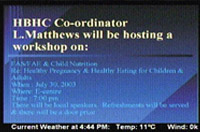Community Radio and Community Cable TV
Community broadcasting in Fort Severn took the form of community radio and cable television. Fort Severn started its community radio station in the late 1970s, around the same time that other First Nations in the region were also launching community radio. The community radio activities in Northwestern Ontario were inspired and supported by Wawatay. Wawatay Native Communications Society (www.wawataynews.ca) was formed in 1974 by the people of the Nishnawbe Aski Nation in Northern Ontario to provide radio, television, and print media services for the Ojibway, Cree and Oji-Cree communities in the region. Eventually television was introduced into Fort Severn, and soon it became more popular than radio, the same thing that happened in many communities across northern Ontario and across Canada as well.
Community radio in Fort Severn
The first community radio station in Fort Severn was located in the band hall, a recreational space where community events would take place. At the beginning, the community had a radio station manager but that position eventually disappeared. Currently the radio station is housed in the Fort Severn e-Centre and managed by the e-Centre coordinator – Lyle Thomas.
When the radio station started in the 70s, it quickly became the main means of communication in Fort Severn. The community radio station broadcast messages, information, music and programming of all kinds. If a community member was looking for someone or something, or wanted to let people know about an event or some news, they would go to the radio station and have it announced over the airwaves.
One of the immediate impacts of this new form of communication was that radio really opened up the sharing of information in the community. A lot of people learned things instantly rather than individuals phoning each other, or visiting to tell each other what had happened. The radio was instant; everybody knew what happened at the same time. People in Fort Severn always had their radio on and would hear announcements such as “so-and-so's looking for you.”
Another impact of community radio was that Fort Severn community members were exposed for the first time to a wide range of news and information, and hearing what people were talking about in other communities. Eventually radio bingo began and that remains a popular use of community radio today.
Wawatay radio programming was and still is broadcast on the community radio. In Fort Severn, Wawatay broadcasts are primarily in Cree. Now the listeners are mostly elders but in the early days and through the 1980s, the listeners included Fort Severn teenagers.
Currently there is only one community radio channel for local programming, 89.9 on the dial, and it is almost always tuned into Wawatay which broadcasts news and call-in programs, and gospel shows at night. There can be a problem if a community member wants to broadcast something different. So for example, if one of the community youth wants to broadcast some music, he or she needs to cut into the regular Wawatay programming. Then the regular listeners phone the e-Centre to ask for Wawatay to be put back on. The solution that the e-Centre coordinator is exploring involves giving Wawatay its own radio channel and having a separate channel for community programming. It will be like having two different radio stations.
Community teenage radio programming
In the 1980s, the teenagers in Fort Severn used the radio station to broadcast popular music. At that time a lot of people would hang out at the radio station just to play music and socialize, and there was no shortage of people who wanted to broadcast their favourite music.
The teenagers had some time each day at the radio station to play their music. They played 80s music, country music, and whatever people requested. Some teenagers would bring in stacks of their own records and play them. Many young people in Fort Severn participated in these music session broadcasts, and they received many requests for particular music choices. Community members who participated back then recall how much fun they had.
At that time, there were many Fort Severn community members listening to these teenage broadcasts. Eventually, with the onset of television, the radio kind of died. The elders still use it, mostly because the main broadcasts are in Cree.
Television in Fort Severn
 Television arrived in Fort Severn via satellite dishes located near the band office. At the beginning, there were only two channels, and not many choices for programs and broadcast times. Community members with televisions in their home could pick up these two channels for free, but they had to watch whatever was showing at the time. One community resident remembers getting up early in the morning to watch his two favourite programs that were broadcast before nine in the morning.
Television arrived in Fort Severn via satellite dishes located near the band office. At the beginning, there were only two channels, and not many choices for programs and broadcast times. Community members with televisions in their home could pick up these two channels for free, but they had to watch whatever was showing at the time. One community resident remembers getting up early in the morning to watch his two favourite programs that were broadcast before nine in the morning.
In some houses, watching television was a community affair. One community resident recalls that he and a group of young children used to hang out at a relative’s house in the evening. It was just a small house and the group of them would arrive and plop down and watch TV, not bother anybody or anything, just watch TV, whatever was on. This happened almost every evening.
The band office had a satellite television dish but it could pick up only one channel at a time and not everyone could agree on what channel to watch. Wrestling was popular back then and people were unhappy when they were watching a program and somebody put the wrestling on. Someone would go over to the band office and physically turn the dish and change the channel. And a lot of times people would go over there and they would turn it on the wrestling channel. Meanwhile somebody was watching a program and it got cut off. Some community members didn’t really like this situation and that's when they started working toward getting their own cable system.
Fort Severn community cable TV service
In 1991, community members met and agreed to develop a community cable television service. One community member bought a license for the system and the community set it up as a community business. The cable was brought to every house in the community, and the households pay a monthly charge for it. The community cable brought in many new channels, and for the first time people could choose what to watch on television.
At the beginning, watching television often remained a family or community activity; people used to watch TV together back then. Then the VCRs came in, and community members began watching movies on VHS, and recording and watching television programs at times convenient to them. One community member recalled that everything changed after that: fewer group activities, no more hanging out as friends, no more dances.
At its high point, the community cable system had 30 or 40 channels but currently it has less than 10 because of some technical problems. To keep the community members happy with the reduced service, the cable network is not charging them for service for one year. Some community members are switching to satellite TV, where they can get more than 100 channels.
Community members see both positive and negative impacts of television in Fort Severn. On the positive side, community members learned about events happening outside Fort Severn on the powerful medium of television. The information was available for the first time, and people knew what was happening around the world from watching the news channels. Some people believe that television has had a tremendous positive impact on the children in Fort Severn. It has opened up the world to them and given them a bigger picture of what is happening nationally and internationally.
On the negative side, some community members believe that a lot of children lose their language because they spend so much time watching TV. One community resident recalls that when he was younger, sometimes he and his friends would stay up all night watching the TV. People started spending more time watching TV and less time out and about hanging out as friends, hanging out as family and walking around the community talking to each other. Before television came to Fort Severn, every evening people used to be outside walking around starting at nine or ten o'clock and continuing until late at night, if there was still light at night. That stopped soon after the cable television was introduced.
Community TV channel – Channel 9
 For the past 10 years, the community cable TV system has had a community channel – Channel 9. It, like the community TV system, is operated by the Fort Severn e-Centre coordinator. Channel 9 is used to advertise current events and community news. The e-Centre coordinator operates Channel 9 by using a computer to create a series of messages, and then broadcasting the messages on the computer screen. Channel 9 is currently considered to be the best way to communicate with community members about events going on.
For the past 10 years, the community cable TV system has had a community channel – Channel 9. It, like the community TV system, is operated by the Fort Severn e-Centre coordinator. Channel 9 is used to advertise current events and community news. The e-Centre coordinator operates Channel 9 by using a computer to create a series of messages, and then broadcasting the messages on the computer screen. Channel 9 is currently considered to be the best way to communicate with community members about events going on.
It is very popular; many community members keep their TV tuned into Channel 9. So for example, one community member who switched to satellite TV keeps a second TV tuned into Channel 9. It is very important for her to know what's going on in the community. Channel 9 carries all kinds of messages, such as community gatherings or social messages like “Don't drive around fast, watch out for children,” and messages about birthdays and weddings.
